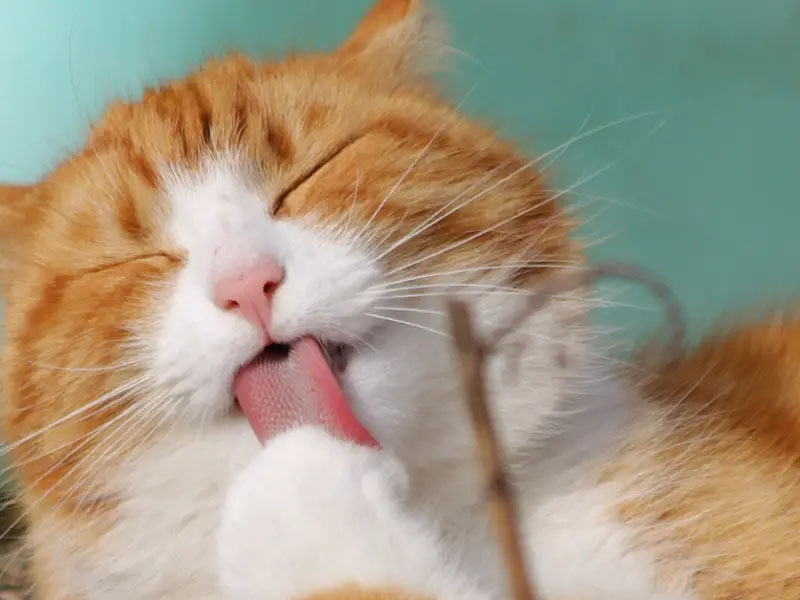
The Best Cat Hairball Remedy: 12 Solutions That Really Work
This post may include affiliate links. Please read my disclosure policy.
Cat hairballs—if you’ve ever lived with a cat, chances are that at one time or another, you’ve come across (or even stepped on) one of these gooey tubular masses of grossness.
Needless to say, we’d much rather spend our time cuddling with our cats than cleaning their hairballs off of our floors or feet.
Here are 12 tried and proven cat hairball remedies you can try at home.
12 Simple Remedies to Prevent Hairballs at Home
1. Brushing
Of course, one of the best hairball remedies is to stop them in the first place.
Regular brushing is a natural cat hairball remedy since it removes much of the excess fur that would normally be swallowed and regurgitated, reducing hairball formation. This is especially true for most long-haired cats.
It also provides a special opportunity for some bonding time with our kitties.
While some cats just love being brushed, others may not be quite so enthusiastic. Introducing grooming time gradually may help them adjust with as little pain (for cat or cat parent!) as possible.
Start with one or two strokes with a grooming glove from HandsOn® Gloves and follow up with special treats so your cat associates this time with something positive.
- Gentle bristles allow for effective grooming without uncomfortable friction
- Can handle short, medium, long, and coarse fur
- Tough enough to withstand baths, playful nibbles, and lots of love!
- The scrubbing nodules work to stimulate circulation and distribute natural oils, promoting a healthy skin and coat for your pet
Another paw-some tool I’ve dug up for kitty grooming is the Furminator. It’s small enough to fit in the palm of your hand, and it’s a great way to gently remove excess fur and prevent hairballs in cats.
You can gradually increase the time spent brushing as your kitty learns to tolerate, and hopefully enjoy, this quality time spent together.
- Stainless steel de-shedding edge reaches through topcoat to safely and easily remove loose hair and undercoat without damaging topcoat or cutting skin.
- Fur ejector button easily releases hair
- Curved edge glides over skin, preventing digging in at edges
- Ergonomic handle designed for comfortable, easy grooming.
Brushing doesn’t have to be a long, drawn-out process. Just a few minutes each day is usually enough for long-haired cats, and short-haired cats may only need to be brushed a few times each week.
2. Bathing
After you’ve brushed your cat, take hair removal to the next level by giving your cat a bath.
Bathing your kitty can be a great hairball remedy since you’re removing the loose fur for her. While most cats prefer to groom themselves, if your cat is prone to hairballs, you may have to take matters into your own hands. Remember to use a shampoo that is safe for cats, as they are very sensitive to over-drying and scented ingredients; do not use dish soap or human shampoo.
3. Wipes
After brushing your cat or after your cat is dried off from their bath, take a pet wipe and gently pat your cat with it, collecting any loose fur. This further helps prevent hairballs in cats.
Make sure to use a wipe that’s safe for cats, like this cat wipe. Or you can simply wet a paper towel and use it to collect the loose hair from your cat’s coat.
4. Pumpkin Powder
Using pumpkin powder is another great hairball remedy for cats. It contains lots of fiber that helps move the hairball through your cat’s digestive tract and most cats love the taste.
Sprinkle a little pumpkin powder on their food to provide fiber and nutritional value. Remember to always have fresh water available when you add dry ingredients to your kitty’s diet.
5. Carrots
Carrots are another good source of fiber and can help move a hairball along and maintain a healthy digestive tract. They’re generally considered safe for cats as long as they’re cooked until soft.
You should never give your cat raw carrots as it can lead to further digestive issues. Also, carrots can be high in sugar. A small amount is all that is needed, and overfeeding carrots can lead to weight gain.
Pin Me!
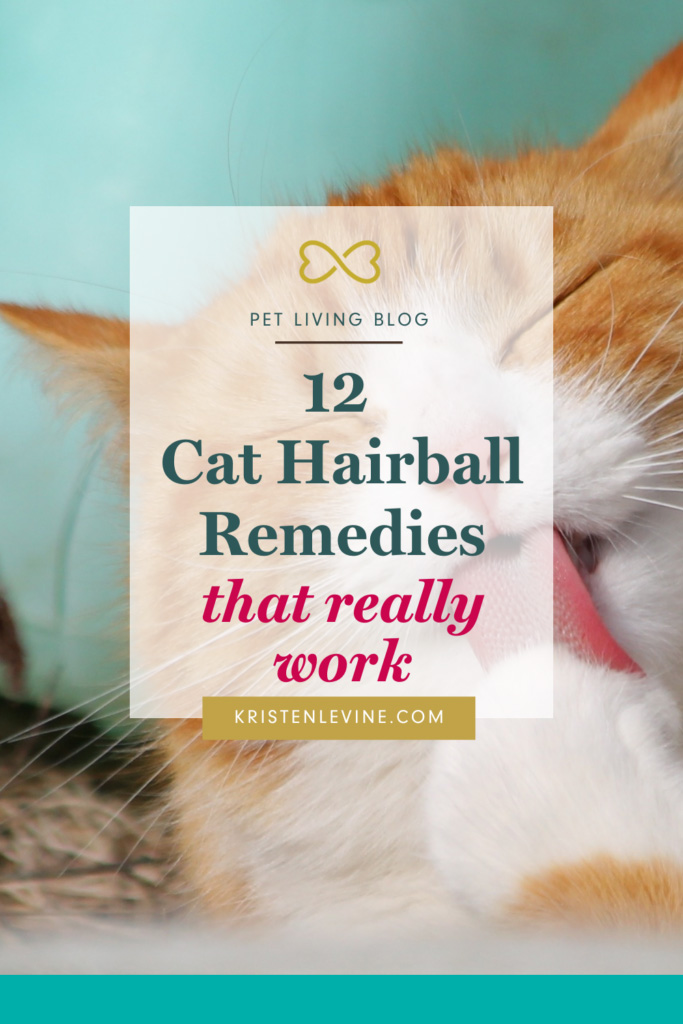
6. Hairball Control Treats and Food
Temptations Hairball Control Treats
Treating hairballs in cats can also be as simple as a delicious treat! I love these hairball control treats not only because they help eliminate hairballs but also help your kitty maintain good dental hygiene You can use them as a low-calorie treat or as a meal topper.
The chicken flavor tastes good to most cats, so you won’t have to convince them to take their cat hairball “medicine.”
Nulo Freestyle Hairball Management Food
One reader from Facebook commented, “I’ve not had to use anything extra since switching them all to Nulo Hairball Management.” We love to hear about things that work for real pet parents!
This food promotes hairball control, as it contains miscanthus grass, which is loaded with fiber to help your cat pass hairballs as well as essential fatty acids to keep your cat’s digestive tract lubricated.
- Turkey and cod recipe made for hairball management with natural fibers from miscanthus grass to promote your cat's digestion and support their coat.
- Formulated with Vitamins E and C and Omega-3 and -6 fatty acids to support a healthy immune system and beautiful, shiny coat
- Made in the USA with no corn, wheat gluten, soy, artificial preservatives, colors, or flavoring.
Purina One Hairball Formula
Another reader swears by Purina One, saying, “I’ve used Purina One Hairball control dry mixed into their dry food. No hairballs for years.”
This formula is also loaded with fiber but is high in protein as well.
Whatever food or treats you decide to use should contain plenty of fiber to help your cat pass hairballs with ease. Check with your veterinarian for optimal feeding advice.
7. Tomlyn Hairball Remedy
This hairball “medicine” comes as a gel or soft chew. It contains Omega 3 fatty acids and lubricants designed to make your cat pass the hairball naturally and safely. Lubricants are one of the best ways to help your cat pass a hairball.
8. Olive Oil
Olive oil is one of the best natural cat hairball remedies. It acts as a natural lubricant, and a little goes a long way! A teaspoon over the course of a week is fine for most cats and will help them pass a hairball naturally.
9. Fish Oil
This might be your cat’s favorite hairball remedy! Small canned fish like sardines, as well as tuna, are usually packed in oil.
Give your cat a treat and add a little oil to your cat’s diet. The lubrication will assist your cat to pass the hairball into her litter box without discomfort.
10. Nutri-Vet Cat Hairball Support Paw Gel
This petroleum alternative is a mix of several vegetable oils and does a great job helping hairballs pass through the digestive tract. Simply add it to her food or put a small amount on her paw – she’ll enjoy the chicken flavor and you’ll enjoy not cleaning up as many hairballs.
11. Water
Something as simple as proper hydration can prevent hairballs in cats. If a cat’s diet isn’t providing enough moisture, her digestive tract is working harder than it should, which may make her hairball problem worse.
Turtle loved to drink from her Catit fountain!
Most cats actually prefer to drink moving, running water. That means even if your cat has constant access to a nice clean bowl of water, she may not be drinking enough. A water fountain is a perfect way to entice your kitty to drink more.
Our Pet Living cats love cat fountains, and they drink to their heart’s content!
A lot of kitties also enjoy very cold water in a glass bowl. There is something just so refreshing about a clear bowl, clean water, and a few ice cubes that may make your cat refresh herself more frequently. Simply drop a few ice cubes in the water once or twice a day and see how your furry feline responds.
Always aim to provide more than one source of water for your cat. That way, she doesn’t have to travel very far to get a quick drink. Some kitties prefer to drink water that is not near their food – so try a second drinking location to encourage water intake.
Drinking water is important, but your cat can also get hydration from her food. A cat who eats a diet composed of mainly dry cat food may not be getting the moisture that she needs.
Gradually introducing canned food with her kibble will increase her water intake. Thus, it will help her digestive tract to move all that hair and debris through instead of sending it back up where it came from.
12. Cat Grass
One Pet Living reader said, “We always have 5–10 cups of organic cat grass growing for them as well as brushing them daily.”
Cat grass is high in fiber, and it even looks pretty in your home!
We love this kind since it’s organic and comes in BPA-free containers.
How to Clean Up Your Cat’s Hairballs
When your cat coughs up a hairball on your floor, it leaves a mess! Because they contain biological material, they can stain and even smell bad, so it’s important to clean them up properly.
Here’s how to clean up cat hairballs the right way.
1. Scoop it up
Scoop up as much of the mess as you can with a paper towel and throw it in the trash.
2. Saturate the area with an enzyme cleaner
This step is critical. An enzyme cleaner like this one will eat the organic material in your cat’s hairball mess.
The surface, whether hard or soft, needs to be saturated with the cleaner so it can get in all the nooks and crannies and eat the odor and stain-causing bacteria.
But it only works if you follow this next step.
3. Allow time for the formula to work
After you’ve saturated the area, place a clean cloth on top and allow it to set overnight, at least for 12 hours. The biggest mistake we see when pet parents are cleaning up pee, poop, or vomit is to spray the area with cleaner and then wipe it away quickly.
Enzyme cleaners need time to dry in order to work. Allowing it to set overnight gives the enzymes time to eat the bacteria.
FAQs About Cat Hairballs
What Does a Cat Hairball Look Like?
A cat hairball, also known as a trichobezoar, often looks like an elongated cylindrical clump. Contrary to what their name suggests, they’re shaped like so because they’ve been formed in the cat’s esophagus. They’re composed of a dense mass of hair, and they may be a few inches long, with a slightly moist appearance and a color that generally matches your kitty’s fur.
Why Causes Hairballs in Cats?
Cats are meticulous groomers, and they use their tongues to get the job done. They much prefer bathing themselves over their humans bathing them.
Cat parents who have enjoyed the occasional affectionate tongue bath from their kitties will be familiar with the rough tongues our furry friends have.
According to Cornell University, the reason why their tongues are so rough is that they’re actually covered by tiny barbs, or papillae, which are perfect for removing dirt and other debris from their coats. They’re also perfect for grabbing excess fur and loose hair, which they then swallow.
Much of the time, this fur can pass through their digestive tract and come out the other end and into a litter box with no trouble.
However, when a large amount of fur becomes trapped in a kitty’s stomach, it gets regurgitated back up in the form of a hairball, or a cat furball.
How Do I Know if My Cat Has Hairballs?
The tell-tale cat hairball symptoms are all very familiar to most cat owners.
They often include coughing, gagging, retching, and hacking.
Most of the time, these sounds signal your cat is about to expel a hairball. So if you’re thinking, “My cat keeps throwing up, but she seems fine,” it could be that she’s just passing hairballs.
Are Hairballs Dangerous to Cats?
Yes, hairballs are potentially dangerous to cats. Long-haired cat breeds are at greater risk of developing hairballs than their short-haired counterparts.
There are some insidious signs that your cat is having difficulty with a hairball and may need medical attention.
While hairballs typically pass, it’s possible for them to become so large they lodge in your cat’s digestive tract and cause a potentially life-threatening blockage.
When Should I Worry about My Cat’s Hairballs?
If your cat has frequent hairballs or is retching without producing a hairball, has changes in digestion such as diarrhea, constipation, or lack of appetite, has become lethargic, or has a swollen or hard belly, it’s time to skip the home remedies and head straight to your veterinarian.
Also remember that a coughing cat appears similar to a kitty with a hairball. If you hear a lot of retching or coughing, but your cat never brings up a hairball, it may instead be a cough. Check with your veterinarian to be certain.
How Often Do Cats Have Hairballs?
Cats typically pass ingested hair through their digestive systems with minimal issues, leading to infrequent hairball occurrences—usually less than once a month for short-haired cats and possibly once a month for long-haired ones. You’ll need to call your vet if your cat has more than one hairball per week.
What if My Cat Is Trying to Cough Up a Hairball but She Can’t?
If your cat is struggling to hack up a hairball, keep a close eye on them. Unsuccessful efforts to dislodge a hairball could signal something more concerning. Watch for ongoing coughing, changes in appetite, or lethargy, and if you spot these, it’s time for a vet visit. The veterinarian might prescribe lubricant or laxative to help your kitty pass the hairball.
A chat with your veterinarian can lead to simple solutions like tweaking your cat’s diet, like increasing fiber intake, to prevent future issues. The goal is to manage hairballs without causing additional stress to your cat’s system, so vet-approved remedies are the way to go.
Is Vaseline Good for Hairballs?
Vaseline may help your cat pass a hairball through their digestive tract and is generally considered safe and nontoxic for cats. However, we don’t recommend it here at Pet Living since it’s a petroleum product, and there are many other more natural alternatives.
The Tail End
Cat hairballs are no picnic for you or your cat, but with regular grooming, proper hydration, a high-fiber diet, and sufficient lubrication, they can become nothing more than a minor annoyance.
Looking for more ways to keep your cat healthy? Download our free cat health checklist!









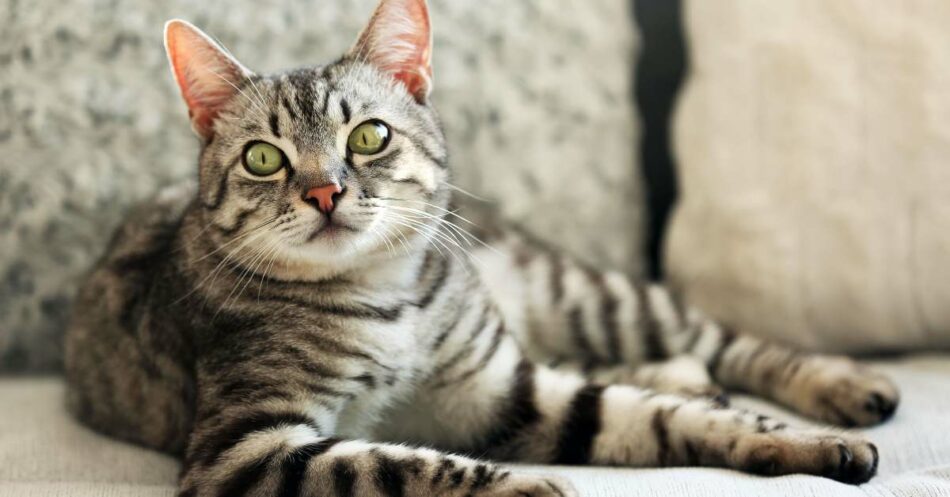
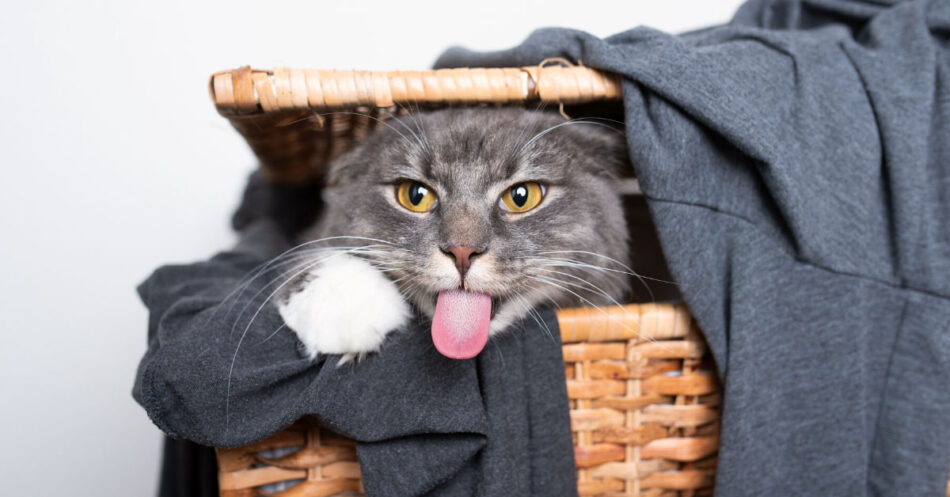
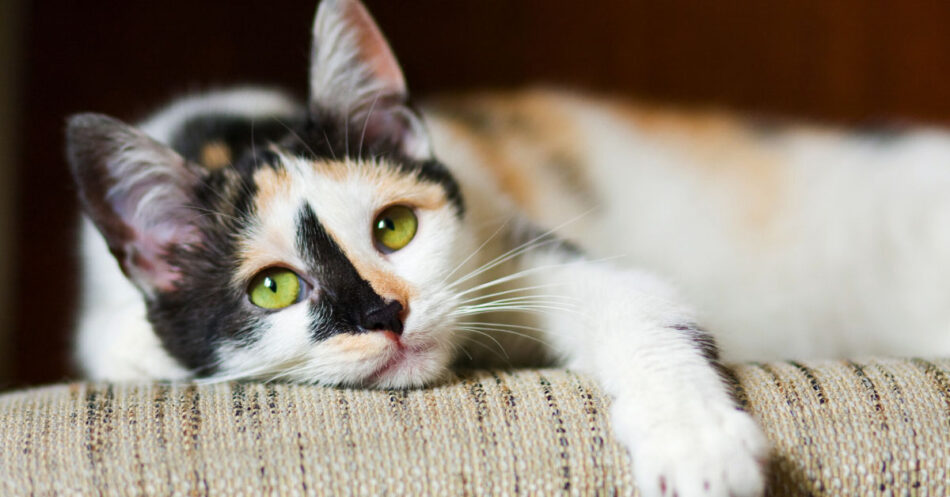
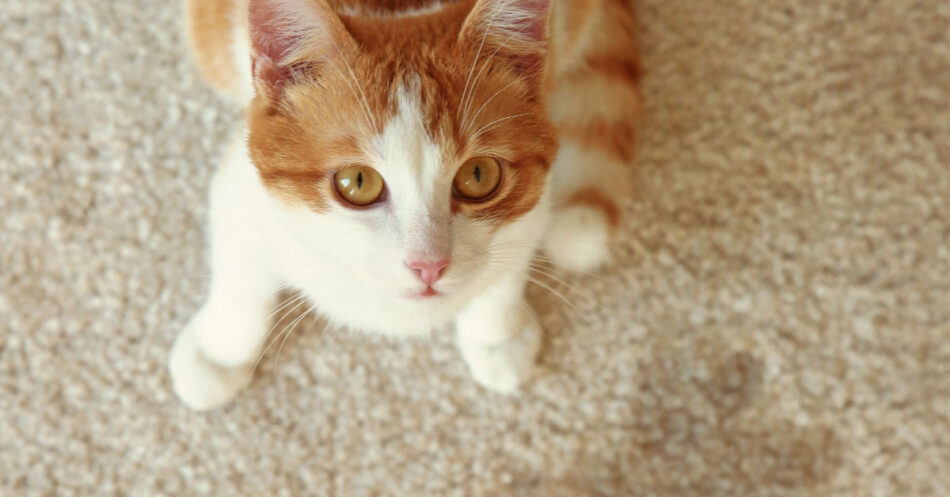
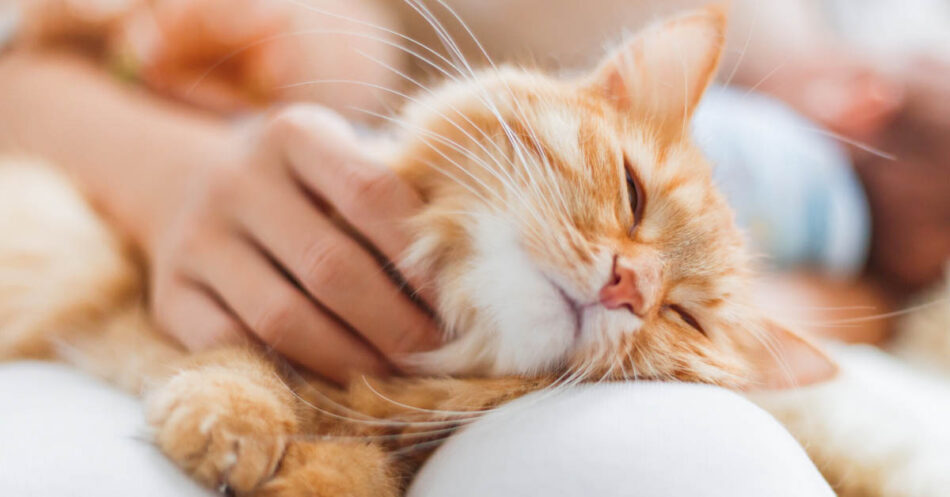
please help my cat wont eat and its giving me sleepless night PLZ HELP, if anyone has a remedy email ericmapuyakagmail.com am from kenya little vet services
Hi Eric,
I am so sorry to hear your cat won’t eat! This is definitely a concern I would discuss with your vet. Not eating can cause other health issues and you want her to stay healthy! Has she had any recent changes in her life? That could cause anxiety and cause her to not eat. Try giving her wet food if you haven’t already. Wet food has a very strong scent that can cause her to want to eat it. Definitely talk with your vet and let me know if you find any solutions!
Kristen
I feed Purina fish pate… Works great
I also have a 20 year old cat. Instead of bathing the cat I use a warm wash cloth and wipe him down. He absolutely loves this as I’ve been doing it all his life. Now all I have to do is wave a cloth in the air and he comes “running” (he’s 20) to get his bath.
Hi Mary,
Too cute! Thanks for sharing! Baths don’t always have to be bad for our cats. Some really love them!
Kristen
I I use NUTRI VET Hairball paw gel for cats! He loves it & it works great! He likes the SALMON flavor!!!!
Ron,
I am glad you have found something that works for your little guy!
Thanks for sharing 🙂
Kristen
My cat doesn’t like any of the hairball remedies i give her, and I’m getting annoyed with gagging and hacking she’s doing. PLEASE HELP!
Have you tried olive oil in cats food. Please look on line for proper amounts to give.
Have you tried olive oil in cats food. Please look on line for proper amounts to give.
I feed my cat wet and dry food.
Does it matter which type of food you add
The safflower oil to?
The wet it will blend in better
can I use avocado oil instead of olive oil??…both my short hair cats are constantly gagging…tried most things, they don’t like any of the solutions so far…quite picky I guess…no olive oil in my house we use avocado instead…
Hello Jeanne,
I’m so sorry to hear your kitties are having hairball issues – I know how upsetting that can be!
I don’t recommend avocado oil for cats as a rule. Here’s why: avocados contain persin, which is toxic to cats. However, we don’t know exactly how much a cat can eat before it affects them – or how much persin any particular avocado oil has. For example, one batch of avocado oil could be low in persin but another could include some of the oils from the pits, which are high in persin.
So, while cats may be able to eat some avocado oil with no ill effects, that could change if the next bottle happened to be higher in persin or if your cat had just a smidge too much.
Kristen
I need to know how to safely and easily remove hair balls from my cat’s fur. All the solutions for hairballs on the Internet seem to focus on how to get cats to eliminate them using diet. However my 12-year-old girl had a stroke 2 years ago. Her health is good, and her appetite is great, but she’s fairly immobile and she can’t groom herself. She is a long hair miniature part Maine Coon. We brush her daily, but her undercoat and especially areas around her rear end and under her tummy get extremely tight hairballs.
Combing these out is very uncomfortable for her; and I hesitate to cut them off for fear of cutting her delicate skin.
Is there any known way to remove external hairballs from a cat’s fur?
Thank you very much
Hello Bob,
You’re absolutely right about how delicate a cat’s skin is – it definitely takes extra care and the right tools to safely remove hairballs and mats from a cat’s fur. However, we can’t just leave them there, as mats themselves can also cause our cats pain. A groomer that has experience working with cats is usually your safest best. If your kitty doesn’t have experience with a groomer or is anxious in new situations, a Fear Free Certified Groomer is a great idea. You can find one near you on the Fear Free website. I’m Fear Free Certified myself, so I know how seriously they take providing a calm and positive experience for your pet. They also may be able to provide tips specifically for you and your pet on the best way for you to keep your kitty mat-free and feeling her best :-).
Hope this helps!
Kristen
Thank you for these helpful remedies! I’ve tried a few of them already, and I’ve noticed a big difference with my cat. Especially the coconut oil trick—she loves it! Can’t wait to implement the others and see how they work.